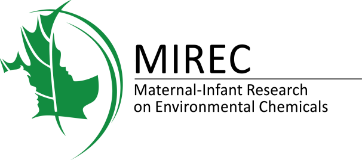
Exposure to free and conjugated forms of bisphenol A and triclosan among pregnant women in the MIREC cohort.
Arbuckle TE, Marro L, Davis K, Fisher M, Ayotte P, Bélanger P, Dumas P, LeBlanc A, Bérubé R, Gaudreau E, Provencher G, Faustman EM, Vigoren E, Ettinger AS, Dellarco M, MacPherson S, Fraser WD. Environmental Health Perspectives. 2015;123(4):277-84. doi: 10.1289/ehp.1408187
In the past few years, there has been increasing media coverage of the potential health risks of the environmental chemicals bisphenol A (BPA) and triclosan. Exposure to these two chemicals is wide-spread, by virtue of their presence in commonly used products. BPA is used to make hard, clear plastics and may also be found in epoxy resin linings on the inside of metal-based food and beverage cans. Thermal papers such as receipts and tickets may also be a source of BPA. Triclosan is used as an antimicrobial in a wide range of cosmetics and personal-care products, including some toothpastes, liquid hand soaps, and non-prescription drugs.
The levels of these two environmental chemicals have often been measured in one-time urine samples from the general population. But much less is known about the levels of BPA and triclosan in pregnant women. To address this knowledge gap, MIREC researchers used stored samples of urine collected from pregnant women in the MIREC Study (from the MIREC Biobank). The MIREC Study (www.mirec-canada.ca) was designed to measure levels of exposure to environmental chemicals during pregnancy, as well as to investigate the potential health effects that prenatal exposure may have on pregnancy and infant health.
MIREC researchers measured BPA and triclosan levels in first-trimester urine samples from about 1,890 pregnant women in the MIREC cohort, and also took into account certain characteristics of the women in the analyses. They found that BPA levels were higher in women with a lower household income (< $50,000), those under 25 years of age, in smokers, and in women with the least education (less than high school). In contrast, triclosan levels tended to be higher in women 25 years of age or older, those who had never smoked, women who had a higher household income (> $100,000), and in those with a university degree.
These study results also suggest that the maternal characteristics linked to higher levels of BPA in pregnant women’s urine act in the opposite direction to maternal characteristics linked to higher urinary levels of triclosan.
The findings from this study represent the largest national-level data on levels of BPA and triclosan in the urine of pregnant women. This newly acquired information will be an important resource for future studies on the potential health risks of exposure to these environmental chemicals.
MIREC Année all rights reserved - Privacy policy
Website by Riposte


